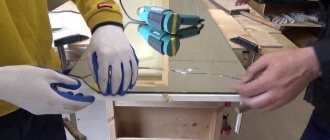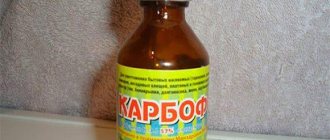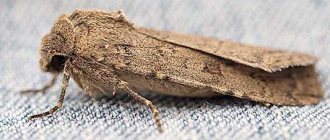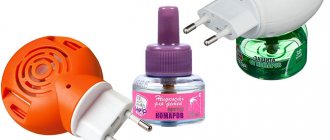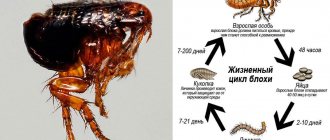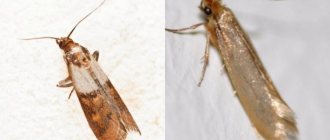Moths are a pest that enters the house and causes a lot of trouble for the owners. Not only clothes made of wool or fur suffer from voracious insects; depending on the type of pest, food and even furniture can be at risk.
To successfully fight moths, you need to know about the stages of insect development, since the main danger is not the adults, but the larvae.
Description and characteristics of the insect
Moths are lepidopteran insects. There are more than 2,000 species in the world, representatives of which are characterized by small size, narrow wings, and nondescript camouflage coloring.
Almost all types of moths begin to become active at dusk. Adults do not eat, but subsist on nutrients that were accumulated during the caterpillar stage. But the larvae are very voracious. They cause the main damage to plants, products or tissues (depending on the type of moth).
Appearance of a moth
Despite the diversity of species, outwardly all members of the family are similar to each other. An adult food or clothes moth looks like a moth ranging in size from 0.5 to 1.3 cm. The color varies from gray to brown, the wings have a slight pearlescent tint.
If you look closely, you can distinguish food moths from clothes moths both by size and color. The dress one is slightly larger, and the color is closer to golden brown. The food is smaller, and the shade of the wings is darker, brownish-gray.
Varieties
Lifespan
How long a moth lives depends on environmental conditions and the type of pest. On average, the lifespan of an adult is from 1 to 4 weeks. The larval stage, during which insects actively feed and cause the main damage during their life, lasts from 1 to 4 months.
What is food moth?
In our homes we can find 3 types of food pests: most often we have the flour moth, less often, but quite often we come across the cocoa moth (very similar to clothes moths), rarely, but there is the southern granary moth (the fight against it is the most labor-intensive). And no matter which one you have, you must understand that this is not only a butterfly flying past, but also pupae, larvae and eggs living with you. Most often, the cause of this scourge is cereals, flour, dried fruits, spices or other groceries brought from the store. And it is there that the larvae hatch from the eggs, then pupate and turn into butterflies. All butterflies look approximately the same and are a butterfly with wings 7 - 8 mm long. But the larvae are all the same and are a caterpillar up to 1.5 cm long, white and yellow in color. Interesting fact: In nature, there are moths that replenish fluid loss by sucking tears from sleeping animals. Thus, the Madagascan moth Hemiceratoides hieroglyphica drinks the tears of birds at night, and the moth Mecistoptera griseifusa even drinks from crocodiles and other large animals.
Types of house pests
The definition of “domestic” refers to all types of moths living in an apartment or house. There are several main types of house moths:
- food (lives mainly in the kitchen, eats cereals, cereals, nuts, dried fruits);
- clothes (lives in closets with clothes, feeds on fabrics);
- fur coat (eats fur);
- furniture (settles on upholstered furniture, feeds on its upholstery);
- carpet (lays eggs and develops in the pile of various carpets).
The differences between species are not only in what the moth looks like, but also in where it lives and what it eats. Thus, clothes moth larvae will never end up in a package of cereal, and food moths will not spoil a fur coat or woolen sweater.
Main types
A moth is a very small butterfly whose wings are 7 mm maximum. If you put them together, you get a small triangle.
Currently there are the following types of moths:
- food;
- chestnut;
- cabbage;
- poplar;
- woolen;
- apple;
- rowan;
- potato;
- furniture.
Particular attention should be paid to what each of the above types of lepidopteran pests looks like.
There are not many of them, but such moths often cause significant damage to various things, food or humans.
food pest
The food moth is another small house insect. Its main types are such varieties of this moth as moth. This butterfly is active mainly at night.
What does such a food parasite look like? Its dimensions are 0.3-1 cm. This moth has a light gray or brown color.
This type of lepidopteran insect lives for 1–2 weeks. At this time, its larvae are formed, which spoil food or harm human health.
Such a moth reproduces only in those places that are comfortable for it, where there is a lot of moisture and water. In such a situation, its females lay eggs.
Thus, this type of house moth infects the following products:
- cereals;
- various types of nuts;
- cookie;
- chocolates;
- tea;
- spices;
- bakery;
- flour, bread;
- various sweets;
- beans;
- fruits or a variety of dried fruits.
When consuming products that are contaminated with such a small pest, a person causes the following harm to his body:
- a person experiences severe intoxication throughout the body;
- sometimes severe allergies appear;
- immunity decreases.
As a result, if such a lepidopteran moth has spoiled this or that product, it must be urgently thrown into the trash. Also, if this type of butterfly appears in the kitchen, then the person urgently needs to get rid of it.
Chestnut butterfly
Also at the moment there are such types of moths as, for example, the chestnut butterfly. This moth is an adult insect whose wingspan reaches 1 cm and their length is 7 mm.
The wings of this type of parasite have a red-brown color, on which white lines are clearly visible. This butterfly has a brown chest, gray abdomen and black and white legs. The eggs of this insect are 0.3 mm in length and have a light green color.
According to biologists, the invasion of chestnut-like pests occurs for 2 years in a row, and then they are not visible for several years. This butterfly lays eggs on the leaves of a variety of trees, and then caterpillars form from them. They feed on the sap of various plants.
On the leaves of various chestnut trees that are damaged by such a lepidopteran parasite, 1 or several brown spots appear, and the adult insect, upon emerging from the cocoon, destroys the leaf skin.
In the worst case, the chestnut tree loses its own foliage, as 100 or more larvae of this type of butterfly form on it.
Cabbage Moth
The cabbage moth is an inconspicuous small butterfly. The span of its small wings reaches 16 mm.
The wings of this moth are gray or dark brown. However, females have lighter wings than males. The edges of the hind wings have a light fringe.
The eggs of this insect are about 1 mm long. They also have an elongated shape and are covered in green.
This type of garden pest, not a home pest, feeds on various cruciferous vegetables.
In such a situation, he eats cabbage, rutabaga, radish, turnips, radishes, etc.
Poplar moth
The poplar moth or moth is a small parasite that damages poplar trees. This butterfly has black dots on its wings.
The narrow wings of this type of moth are covered with fringe, and their wingspan reaches 7 mm. This insect has a nondescript brown color.
Such a moth does not cause any harm to humans. The moth does not feed on various foods, does not destroy things or clothing, and does not spread specific ailments.
The presence of such a butterfly in the house causes more harm to the human nervous system, so the tenant gets rid of it as quickly as possible.
Sometimes such a lepidopteran pest flies into electrical appliances, equipment or lamps, causing them to malfunction and damaging their appearance.
In addition, pestra stains furniture and also sticks to curtains and tulle. Thus, this insect leaves behind stains that are difficult to remove.
wool butterfly
The wool moth is the most common type of this insect. Such a butterfly appears not only in various apartments and warehouses, but also in mills or museums.
The larvae of this parasite feed on contaminated clothing or dust.
The wings of such a moth correspond to the size of any similar insects - up to 2 mm. The front wings are covered with brown, which gives a pearlescent light tint.
The hind wings of this woolly pest are beige in color, and their edges are covered with fringe.
This type of parasite is very prolific. After all, his female lays up to 90 eggs during her short life.
Apple tree small pest
Apple moth is considered a dangerous small pest. This light butterfly lives in large and small apple orchards.
More often, the apple tree suffers from the adult larvae of this moth. After all, various garden moths feed on its leaves.
With a large number of apple parasites, the leaves curl inward, dry out, and then fall off. As a result, the apple tree remains without fruit for a long time.
Rowan Moth
What other moths are there? Rowan moths are also often found in garden plots. It is a small gray butterfly with a maximum wingspan of 1 cm. The length of this parasite is 6 mm.
The caterpillars of this pest are 1 cm long. They have a green-gray color, which sometimes has a red tint.
This insect feeds on the fruits of hawthorn or rowan. During mass reproduction or in lean years for rowan trees, this butterfly damages not only rowan trees, but also apple trees.
Potato butterfly
The potato moth or fluorimea is an inconspicuous insect. The eggs of such a butterfly are small in size (about 0.44 mm), so they are very difficult to notice.
The eggs of this insect are oval in shape and white in color, but as the embryo develops they darken. Egg clutches are located on the reverse leaf side and develop in only 2-3 days.
If fluorimea is infested on a plant, it completely destroys the entire bush - from the very top to the underground tubers.
Moreover, not only the potatoes themselves suffer, but also vegetables such as tomatoes, peppers, eggplants, etc.
As a result, when they attack crops, fluorimea moths harm people in the following way:
- weaken several potato or other bushes at once;
- reduce the quality of potatoes;
- sharply reduce the amount of seed potatoes;
- reduce productivity.
Furniture parasite
Furniture moths are considered another type of this small pest. The larvae of such a butterfly gnaw a small path to their food and their movement route is similar to tunnels.
In food that contains many natural ingredients, the larvae of this type of moth in an apartment grow at a very fast pace. As a result, after 25–30 days, they become sexually mature parasitic individuals, which then mate with females and quickly reproduce in closets with clothes.
Females of such lepidopteran insects are considered very fertile butterflies. After all, the number of eggs of this parasite in 1 oviposition sometimes reaches 200 pieces.
This type of lepidopteran moth is a serious small pest in a person’s home.
This butterfly feeds on clothes, carpets, various rugs or furniture upholstery.
In addition, this lepidopteran pest eats fur, wool, feathers or various products - animal bristles, which are used to make toothbrushes, as well as fiber for pianos, etc.
Reasons for the appearance of the house
A moth cannot appear out of nowhere. There are several main ways pests can enter a house or apartment:
- food moths can be brought with contaminated products (there may be eggs or larvae of the pest in flour or cereal);
- Moths can be contaminated with used furniture, carpets, and second-hand clothes;
- the insect can also get into the house on new clothes if pests live in the store or warehouse;
- through the ventilation duct from the neighbors.
Another option is that moths fly in from the street through a window. However, given that insects do not fly well, such cases are extremely rare.
Natural "camouflage"
Nature gave such an inconspicuous color to moths for a reason. First of all, because the earthy shade is an excellent protection and allows you to avoid an unpleasant encounter with a hungry predator. An interesting fact is that representatives of different species of moths living in a particular environment acquire colors in accordance with its conditions. For example, the development of moths of forest species is more characterized by a greenish tint, while others are more characterized by the color of the bark of trees, which are more abundant in this area.
But science has become aware of an even more unique phenomenon, a property that only very few representatives of the insect world can boast of. It has been observed that in urban areas where there is heavy soot pollution, some species of moths actually become darker in color than insects of the same species living in less polluted areas.
Another effective form of camouflage is the shape that the insect takes on when at rest. Species that live primarily in tree crowns, as a rule, do not fold their wings at all in order to be more like dry leaves, while “grass” ones actually extend their wings into a line so that they cannot be distinguished from a blade of grass. Not least important is the flight strategy of the moth.
Few of these species fly straight and slowly. Many of us have observed house moths flying around in such a way that it becomes difficult to catch them. Light excites the insect, forcing it to be even more active, so the closer the light source, for example, a light bulb, the faster the moth will fly and the more chaotic at first glance its direction vector will be, which most often becomes circular.
An effective form of defense that other flying insects could take a few lessons from the moth is mimicry. Mimicry is the ability of a living organism to simulate the appearance of a larger or more threatening creature. This form of defense is used both by caterpillars with tails that look like the large head of a poisonous snake, and by adult individuals, whose war-spotted coloring on the outer surface of their unfolded wings scares off even large birds. Mimicry is also characteristic of some species of butterflies.
Signs of infection
At first, it is not so easy to determine that moths have appeared in the house. But over time, as the number of pests living in the apartment grows, traces of their presence appear more and more clearly. The presence of a moth is indicated by the following signs:
- small holes with uneven edges appear on clothes;
- larvae can be found in flour and cereals;
- in cabinets where moths live, you can see cobwebs, remains of cocoons, and waste products.
If gray moths begin to appear in the room, moving chaotically in the air, this is a sign that there are already quite a lot of insects.
What harm does the insect cause?
Groceries affected by food moths become unfit for consumption and must be thrown away. Large food warehouses often suffer losses due to this pest. Food stocks with moths cannot be sold. During their life and reproduction, insects leave scales, droppings and pieces of cobwebs in food. These substances are highly toxic. They can cause severe poisoning and therefore pose a danger to humans.
Clothes moths destroy clothing stocks in closets. In a short period of time, they can render most of the fabrics in the apartment unusable. In particularly advanced cases, they can begin to damage furniture. Clothing affected by the pest loses its aesthetic appearance and, most often, becomes impossible to wear.
Moth Reproduction
Reproduction of moths in an apartment or house occurs quite quickly. Adults emerge from pupae ready to reproduce. A few hours after mating, the female lays eggs. Most often, laying occurs where future larvae can easily find food. For example, food moths lay eggs in flour, cereals or dried fruits, furniture moths in the folds of upholstery, and clothes moths in seams or folds of clothing.
Reproduction
In total, a female moth, depending on the species, can lay from 40 to 150 eggs. In favorable conditions (temperature +25... +30⁰С, air humidity above 50-55%), reproduction occurs all year round, during which 2 to 5 new generations of pests may appear.
How to fight insects
It doesn’t matter which way the moth got into the apartment. It is necessary to begin fighting it immediately after identifying the first adults or larvae. The sooner you start doing this, the faster you will be able to get rid of the pest.
Chemicals
Previously, tablets made from a mixture of naphthalene and camphor were often used, but the danger is that their vapors in high concentrations are harmful to humans .
Now there are many safe means:
- "Antimol." Available in tablets. It is enough to put 3-4 pieces in the closet. The tablets are valid for 21-28 days, then they are thrown away. The product is used to repel, not kill, moths.
- "Dezmol" is a drug similar to the previous one. Available in tablets.
- "Molemore." Validity is up to 6 months, but no more than 2 records can be used in one room. The drug repels, but does not destroy, insects.
- “Suprozol” is a drug in the form of an aerosol. Spraying in places where moths accumulate helps to effectively destroy adults and larvae.
- “Supromit” is a liquid product used to treat furniture surfaces. Its validity period is several months.
- "Moskitol" is a product in the form of plates. They are laid out in places that they want to protect from the penetration of moths.
- "Raid Antimol" is a popular drug. Available in the form of plates, gel or spray. The method of use depends on the release form.
- "Raptor". When sprayed onto clothing, it leaves no traces on it and has a pleasant smell.
Antimol is a reliable means of killing moths.
Special sections effectively repel moths. They have a pleasant aroma and can be safely used even to protect children's things. Mount them at the top of the cabinet. 1 section is capable of protecting a space of up to 0.5 m³. At the same time, in a room with an area of up to 15 m³, no more than 2 pieces can be used. The section is valid for 4-6 months.
Destruction of larvae
To fight them you will have to make efforts, because... larvae hide in the most inaccessible places. Clothes moths are easier to remove than food moths. To do this, take things outside and shake them out well, then leave them in the sun, and if possible, wash them at 60°C. After this, they are treated with moth repellents, and the cabinets are also treated.
If food moths are detected, you must urgently get rid of all contaminated food products. Adults are destroyed using aerosols. The shelves on which the products are located are treated with liquid agents or sprays (they must be stored in sealed containers).
Using aerosols, moth larvae are destroyed.
What folk remedies exist
Many people are afraid of the toxicity of chemicals, so they prefer proven traditional methods.
It must be remembered that most of these products do not destroy moths, but simply repel them.
Commonly used folk remedies:
- Orange peel. Place it in places where moths can lay eggs. It repels adult insects. The peel should be changed at least once a month.
- Laundry soap. They put it in the closet and also wash furniture with it. The downside is that the smell gets absorbed into the clothes.
- Lavender, wild rosemary, tobacco, chamomile, fir. It is enough to change bouquets of these herbs once every six months.
- Fir or lavender oil. Place an open bottle in the closet or soak cotton wool in it.
- Geranium. It is enough to have 1 such plant in a room, and its smell will effectively repel pests. It is better to place the flower on the window so that insects cannot get into the house.
- Rosemary, garlic, cloves. They are placed in jars with cereals.
- Vinegar. They are used to treat the surfaces of bedside tables, cabinets, and storage rooms.
- Temperature. Moths are afraid of both heat and cold. Clothes should be washed at 60°C, exposed to the sun at a temperature of about 30°C, or exposed to frost – 10°C.
Folk remedies can help fight moths.
Life cycle of a moth
Moth development includes 4 stages:
- egg;
- larva;
- chrysalis;
- adult insect.
The moth lays eggs, from which larvae hatch after 1-2 weeks. Moth eggs are very difficult to notice with the naked eye, since their size does not exceed 0.3 - 0.5 mm. They can be located either individually or in a group of several dozen. Larvae are small (about 1 mm) light-colored worms. Almost immediately after birth, they begin to actively eat, developing and storing nutrients. It is at this stage of development that insects cause maximum harm.
After a few weeks or months, the larva forms a cocoon in which it metamorphoses into an adult. Moth pupae are inconspicuous, whitish-gray, reaching a size of 4–7 mm. The duration of this stage is from 6 to 35 days, after which an adult, sexually mature individual is born.
Appearance
What does 1 common mole look like? This moth has a yellow color - gray or dark. A red tint is sometimes visible on the body of this insect.
Such a parasite has 2 pairs of shiny wings that shimmer in the sun. A fringe is visible along its edges. The span of the front wings of such a moth is 9–18.5 mm. The hind wings are more uniform in color and smaller in size.
The chest of such a small pest is brown on top and light yellow and shiny below.
The male of this insect is smaller than the female, and after mating with the female and fertilizing her, he quickly dies. The female of this small pest lives for about 1 month.
What do moth larvae eat?
The diet of a moth larva is determined by its species. In nature, larvae feed on animal hair, bird feathers, vegetables, fruits, berries, nuts, and grains. A food moth larva living in an apartment can eat:
- flour;
- cereals;
- bran;
- cereals;
- legumes;
- pasta;
- cookie;
- nuts and seeds;
- dried fruits;
- candies and chocolate.
As for other species, that is, the larvae of clothes, fur, carpet and furniture moths, they feed on:
- natural fabrics (cotton, wool, linen, silk);
- fur;
- synthetic fabrics, if they contain natural fibers.
Nutrition
Even though the larva is tiny and eats very little, a large colony of parasites can cause serious damage to things.
Interesting Facts
Some species have a very long proboscis, or tongue as it is sometimes called, which insects use to suck out nectar or other plant fluids. This proboscis tends to roll up very tightly when there is no need to use it. But while the insect is feeding, the tongue “unwinds” to its entire length, and in some species, in the unfolded state, it can be several times longer than the body.
For example, the Madagascar hawk moth, which is a direct relative of the well-known poplar hawk moth, which we talked about in detail in this article, has a proboscis about 33 cm in length. This unique feature was certainly acquired by the insect in the process of evolution, since its main diet is the nectar of orchids growing in this region, the flowers of which have a very deep “neck”.
However, not all types of moths have such “long tongues”. Many of them have a very short proboscis, and this is also a consequence of evolution, since such an adaptation allows them to easily and efficiently feed on fruit juice.
The remaining species, of which there are many more, do not have a mouthparts at all. More precisely, it exists, but its components are so reduced that there is absolutely no way to use them. It, apparently, is not necessary, since adult individuals throughout their, as a rule, very short life, can waste the energy that they have accumulated while at the stage of a very voracious larva, which is better known to us under the definition of a caterpillar.
Antennae, or, to be more correct, antennae, as well as limbs and many other parts of the body, are literally studded with sensitive receptors that the insect uses to evaluate the environment and search for food. This kind of sense of smell is used mainly for searching for flower nectar and finding a mate for procreation.
Among almost all species of these insects, females fly to meet males, who release their odorous pheromones into the air. These aromatic substances are produced on the last segment of the middle pair of limbs, by scales on the wings or by glands located on the abdominal region. It is worth noting that the female of our ordinary clothes moth is capable of detecting a male at a distance of more than 2 km, provided there is a fair wind, although, of course, she will not be able to fly to him.
How dangerous are moths and their larvae?
An adult moth is not dangerous because it does not bite and does not carry pathogens or infections. The main harm from it is the laying of a large number of eggs, from which real pests - larvae - will appear.
The greatest danger to humans is larvae of food moths. It spoils food and contaminates it with waste products. Cereals or dried fruits in which moths have infested should not be used for food. Otherwise, consequences may arise in the form of:
- allergies;
- digestive disorders;
- poisoning
Clothes moths damage clothing, furniture upholstery, and carpets. For people prone to allergies, wearing moth-infested clothing can cause skin irritation. In addition, the presence of moths causes psychological discomfort.
Is this parasite dangerous for humans?
Unlike other various parasitic insects, moths do not cause much harm to a person and his apartment if it is removed from the house in time. This moth often destroys only certain clothes.
Certain types of moths (for example, the cereal moth) damage food products such as cereals, chocolate and nuts. However, this type of moth does not cause significant harm to humans.
The only disadvantage of such a parasite is the contamination of food, as well as its rotten appearance.
Why are moths dangerous?
It harms a person in the following ways:
- spoils the appearance of food;
- contaminates dishes;
- destroys clothes;
- causes discomfort.
Such a lepidopteran parasite is dangerous to human health only if he does not get rid of it in a timely manner.
Video
Extremely dangerous! About potato moth
How to get rid of moths and their larvae?
Both traditional recipes and chemical preparations will help you get rid of moth larvae. Many housewives take advantage of the fact that moths are quite sensitive to temperature changes. Knowing at what temperature moths die, you can treat things and products to destroy pests.
Adults die at a temperature of -2⁰С, moth larvae at -10⁰С. If we talk about high temperatures, readings of +40⁰С are destructive for imagoes, and +50⁰С and higher for larvae.
Attention! Washing things in hot water or treating them with a steam generator, or heating the cereal in the oven will help get rid of pests. Another option is to take things out into the cold in winter and put the food in the freezer so that the insects freeze and die.
You can fight moth larvae using insecticidal preparations, such as:
- sprays;
- gels;
- emulsions.
Fumigators and traps are also used.
Attention! Strong odors are what moths and their larvae are afraid of. Therefore, folk remedies for pest control are essential oils, plants, and herbal decoctions.
The most commonly used insect repellents are:
- dried citrus peels;
- essential oils (eucalyptus, lavender, lemon, mint, grapefruit, fir, orange);
- herbs (wormwood, rosemary, tansy);
- ammonia, vinegar.
Attention! Moth larvae cannot tolerate sunlight. In order to get rid of them, things can be taken outside or onto the balcony in clear weather.
How does it reproduce
To fight these insects, you need to know how moths reproduce .
This process includes steps such as:
- egg;
- a caterpillar that turns into a chrysalis;
- adult.
Only male moths fly. The female crawls around in search of a secluded place in which she lays eggs.
Moth caterpillars eat a wide variety of things and foods.
The rate of egg hatching directly depends on the ambient temperature:
- if it is less than 13°C, the ripening period is up to 37 days;
- at 33°C – 7 days.
Prevention of occurrence
Preventing moths is easier than trying to deal with existing pests. For prevention purposes, you should follow a few simple rules:
- do not make too large stocks of cereals, pasta, nuts and other products that moths feed on;
- Store bulk products and dried fruits in hermetically sealed glass or metal containers;
- regularly ventilate wardrobes with clothes and kitchen cabinets; it is very advisable to ensure that sunlight enters the wardrobe (you can use an ultraviolet lamp);
- Before storing seasonal items, they must be washed or dry cleaned.
Sachet with herbs
Also, for prevention, you can have geraniums at home, and place sachets with herbs that repel pests or special anti-moth tablets on the shelves of the cabinets.
Insect purpose
Why do you need cabbage or other moths? In addition to the disadvantages, it also has various advantages.
What are the benefits of moths? First of all, such an insect (in particular, the wax moth) is a raw material for the manufacture of effective medicines for tuberculosis, various cardiovascular ailments, lung diseases, or for stimulating the immune system.
In addition, various wax moth preparations increase a person’s immunity and physical activity, and also regulate energy metabolism.
Moths in the apartment - general characteristics
A moth is medium-sized insect from the order Lepidoptera . It is nocturnal , so it can be found mainly in the evening.
The moths themselves are harmless to property - their main function is to leave behind as many offspring . The greatest damage is caused by larvae , which from their very birth begin to actively absorb everything that surrounds them.
Even at the larval stage, the moth consumes so much food that it has enough energy reserves for the rest of its life until the moment of reproduction. Natural death from starvation occurs a few hours after laying eggs. If you notice insects your home , it means that the larvae have already settled in a secluded corner and have begun to destroy your clothes, furniture or food. To understand what exactly was damaged, you need to understand what types of moths exist, where they live and what they eat.
Clothes moth - eater of clothes and furniture
If we look at the pests in the photo, clothes moths have some differences from food moths. It is important to learn to distinguish between them, since the methods of combating parasites will depend on this. The wings of clothes moths are monochromatic and have no noticeable patterns. It is its larvae that destroy wardrobe items and upholstered furniture. Caterpillars can quickly chew a hole in a sweater or sofa upholstery. They leave behind entire tunnels on fur coats and carpets.
Housewives often don’t understand how moths got into the closet.
Often, residents do not understand where moths come from in their apartment, believing that they are taking all precautions. However, it is almost impossible to completely protect your home from pests. There are times when even a pet can bring a parasite into the house on its fur after a walk. After this, the larvae appear on clothes hanging in closets or folded in dressers. That is why many housewives prefer to iron all items before long-term storage of clothes that are temporarily not worn, since high temperatures are destructive for eggs and caterpillars.
Sense organs
Only mosquitoes and honey bees can boast of this type of receptor, developed to a unique state with a huge number of possibilities. But nature has not endowed moths with such a wide range of advantages.
The “fluff” on the body of the caterpillars provides the larva with a sense of touch. Insects sense touch very well using long tactile hairs that grow over almost the entire surface of their exoskeleton and are connected to nerve cells that transmit contact information to the insects' brain.
Sensory hairs on the body of adult individuals are located throughout the body, especially on the antennae. In addition to tactile and “culinary” sensitivity, they provide information about the speed and direction of the wind while the insect is in flight.




